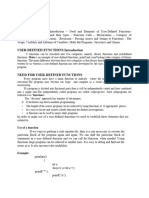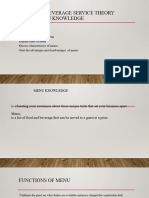0% found this document useful (0 votes)
4 views63 pagesChapter 9
Chapter 9 discusses user-defined functions in C programming, highlighting their necessity for modular programming to simplify complex programs. It covers the structure of functions, including definitions, headers, and calls, as well as the advantages of using functions for code organization and debugging. The chapter also addresses various types of functions, parameter passing methods, and the importance of function declarations.
Uploaded by
seanpaulpongaCopyright
© © All Rights Reserved
We take content rights seriously. If you suspect this is your content, claim it here.
Available Formats
Download as PDF, TXT or read online on Scribd
0% found this document useful (0 votes)
4 views63 pagesChapter 9
Chapter 9 discusses user-defined functions in C programming, highlighting their necessity for modular programming to simplify complex programs. It covers the structure of functions, including definitions, headers, and calls, as well as the advantages of using functions for code organization and debugging. The chapter also addresses various types of functions, parameter passing methods, and the importance of function declarations.
Uploaded by
seanpaulpongaCopyright
© © All Rights Reserved
We take content rights seriously. If you suspect this is your content, claim it here.
Available Formats
Download as PDF, TXT or read online on Scribd
/ 63























































































